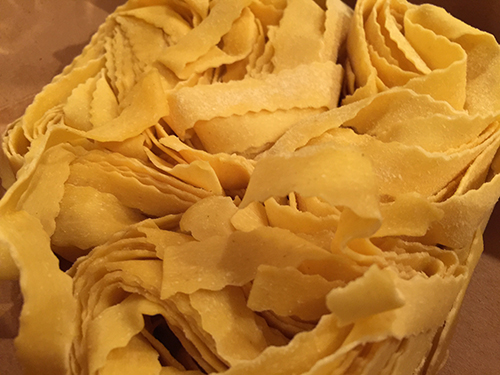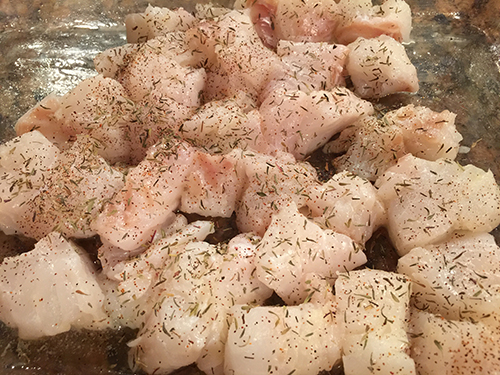Cena Lucana
May 20 was the Day of the Lucani, a completely made-up, sparsely-documented celebration for people whose ancestors can be traced to the lonely region of Basilicata, Italy. This roughly triangular province, called Lucania by ancient Greeks, is the instep of the boot of Italy, a mountainous, relatively arid landscape sandwiched between the Tyrrhenian and Ionian Seas that Norman Douglas called “the Sahara of Italy” in 1915. My great-grandparents came to America from this region in 1903 — as did very many of their compatriots. So much so that in the early part of the 20th century the volume of émigrés exceeded the birthrate.
I’ve visited Basilicata three times (and written a lot about it), meeting people along the way each time. A few weeks ago my friend Daniele Bracuto, a designer from my great-grandparents’ village of Barile, posted a menu exclusively comprised of specialities from that small town.
This is remarkable for a few reasons. First, though many (most?) Italian-Americans can trace their roots to Southern Italy, there is a dearth of cookbooks from there. (Sicily is an exception.) One might attribute this to America’s continued fascination with all things Tuscan, but the truth is that even today there is a real ignorance of Italian culture south of Rome. Christ stopped at Eboli and apparently so did the cookbook authors.
The other reason this is exceptional is that Barile is a tiny place, known really only for three things: 1) an extraordinary wine called Aglianico del Vulture; 2) its position on the slope of a majestic, extinct volcano; and 3) that its citizens lived in caves carved from limestone into the 20th century. Food, you will note, does not distinguish Barile (or, really, Basilicata — there is a reason many Southern Italian dishes use hot peppers). But I was wrong about that and I had a menu to prove it.
Daniele sent me the chefs’ recipes. They were in Italian (of course), some Arbëreshë (I think), and scaled to serve many dozens of people. There was no way I was not going to make it, terrible translation and portioning be damned.
Now, I have been practicing cooking as ancestor worship for a long time (here’s Spaghetti All’assassino, scorched wheat pasta, and Carbone Dolce). But this was a challenge above and beyond. I headed to Eataly in Chicago for expert help. For one, I was looking for tagliatelle mollicate, a kind of thick, serrated linguini I had never heard of. But Antonio, the legit paisan pasta monger at Eataly, knew of it and called it “reginelle” pasta. But Eataly did not carry it, so … he made it, by hand, with a zig-zag cutting tool!
Suffice to say there was a lot of improvisation. I chose two of the four courses from Daniele’s menu. The pasta dish and a cod and bean puree dish. Recipes are included below in Italian lest you make fun of my translation. Original proportions. Run it through Google Translate if you want a real laugh.
Tumact Me Tulez
(Tagliatelle mollicate con sugo alle noci ed alici)10 kg di reginelle
5 kg di mollica di pane
2 vasetti da 500 grammi di alici
16 kg di pelati
2 kg di noci puliteProcedimento:
Preparare il sughetto con olio aglio e separatamente tagliare le alicette a pezzettini ed immergerle nel soffritto. Aggiungere il pomodoro e portare a cottura. A parte in una padella fare tostare i gherighi di noce con la mollica di pane e un po’ di olio fino a farlo diventare croccante. A fine cottura aggiungere una spolverata di prezzemolo. Cuocere la pasta e saltare in una parte del sughetto aggiungendo un po’ di mollica aromatizzata. Impiattare aggiungendo uno o due cucchiai di sugo ed abbondante mollica di pane.
Duo di baccalà su passatina di fagioli di sarconi e peperoni cruschi di Senise
Baccalà 20 kg ammollato
7 kg di fagioli
1,5 kg di peperoni cruschi
2 kg di patate a pasta gialla
250gr di lardo
100 cialde di pane
Timo, Rosmarino, cipolla, prezzemolo, Alloro, peperoncino, aglio.Procedimento:
Baccalà: Spellare il baccalà, togliere la pelle e tagliandola a triangolini farla cuocere in forno con un filo di olio fino a farla diventare croccante per guarnizione. Tagliare il baccalà e creare 100 pezzi di 4cmx4cm circa l’uno, cucinare sottovuoto al 50% unendo timo, poco olio e pepe, cucinando a vapore a 80° (forno a temperatura controllata) se non ha il forno con buste per cottura in acqua quasi al bollore. A parte utilizzando la parte rimanente del baccalà (NB utilizzare le parti più alte del baccalà per i 100 pezzi e le parti più basse verso la coda per la pallina di baccalà), cuocere a vapore controllato sempre con timo olio e pepe e a fine cottura frullarlo insieme alle patate lesse e servire le palline con una pinza pallina gelato.Fagioli: Mettere a bagno i fagioli la sera prima, successivamente scolarli e cucinarli in acqua con poco sale e qualche foglia di alloro. A parte fare un fondo con cipolla tritata, poco peperoncino, un rametto di rosmarino e del lardo. Levare il rosmarino ed unire i fagioli cotti precedentemente. Lasciare insaporire ed aggiustare di sale e pepe. Utilizzare una parte di fagioli interi guarnizione e la restante passarla al passatutto. In fase di guarnizione utilizzare il peperone crusco.
It turned out quite well, all things considered. The sauce for the pasta had the slightest hint of anchovy and a somewhat stronger hint of red chili and the serrations of the pasta held it nicely. The cod/potato mash on top of the bean puree combined for a flavor I had never experienced.
But this is only part one. The real delicacy from the menu I am excited to make, Zuppa dei Brigante (“Brigand Soup”) awaits. For now, though, I have a flight to Italy to catch. Ciao!
















